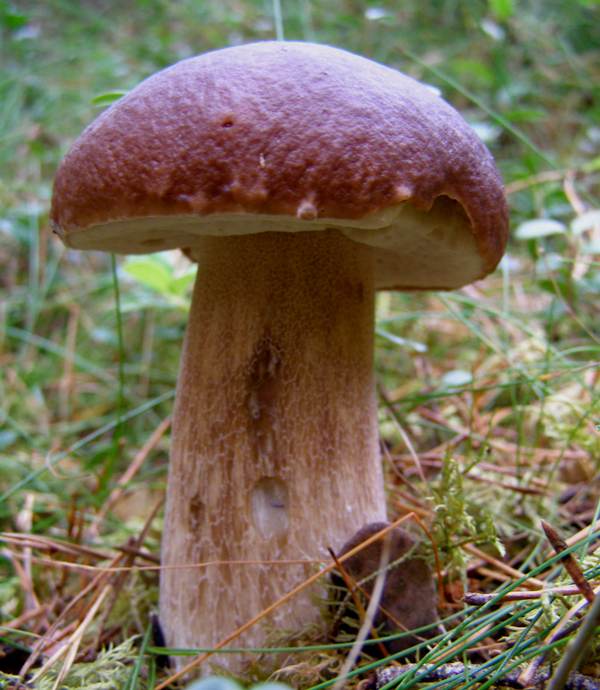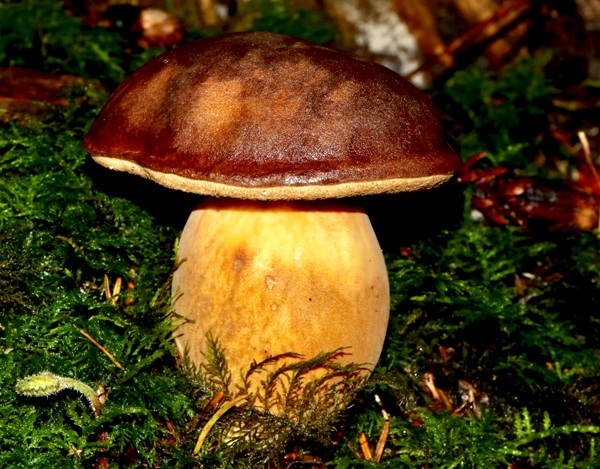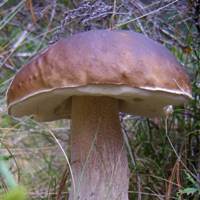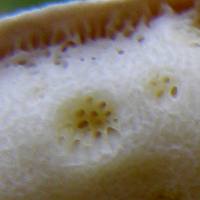Trees Birds Mammals Fish Amphibians Reptiles
Wild Algarve
Bookshop
Boletus pinophilus Pilàt & Dermek - Pine Bolete
Phylum: Basidiomycota - Class: Agaricomycetes - Order: Boletales - Family: Boletaceae
Distribution - Taxonomic History - Etymology - Identification - Culinary Notes - Reference Sources

With its beautiful vinaceous or red-brown colouring, this close reative of the highly prized edible Boletus edulis - commonly referred to as Cep, Porcini or King Bolete - was for many years considered merely a variety ot colour form of the Cep.

Distribution
An uncommon find in pine plantations insouthern and central Britain, Boletus pinophilus is widespread and moderately common in the mature Scots Pine forests of Scotland. This bolete occurs also in many parts of mainland Europe including France and Italy; its range is thought to extend into western Asia.

Taxonomic history
This bolete was originally named and described in 1973 by Czech mycologist Albert Pilàt (1903-1974) and Slovak mycologist Aurel Dermek (1925-1989), who gave it the scientific name Boletus pinophilus, which remains its generally-accepted name.
Synonyms of Boletus pinophilus include Boletus aestivalis var. pinicola (Vittad.) Sacc., Boletus edulis var. pinicola Vittad., and Boletus pinicola (Vittad.) Rea.
Etymology
The generic name Boletus comes from the Greek bolos, meaning 'lump of clay', while the specific epithet pinophilus comes from Latin and means pine-loving - a reference to the association of this fungus species with pines (trees of the Pinus genus).
Identification guide
 |
Cap
8 to 20cm across, initially hemispherical and eventually becoming almost flat; smooth or slightly bumpy; dry or slightly greasy, becoming viscid in wet weather; vinaceous to reddish brown. The cap flesh is white and unchanging, with a vinaceous tint below the cap cuticle. |
 |
Tubes and Pores
The adnate tubes and pores are initially whitish, yellowing at maturity. The pores are unchanging or turn only slightly blue-green when first bruised; the bruised areas gradually turn brown. |
 |
Stem
7 to 12cm tall and 5 to 10cm in diameter; surface light brown with an extensive fine white or pale brown reticulum; clavate or inflated (barrel-shaped). Stem flesh is whitish. |
| |
Spores
Fusiform, smooth, 13-18 x 4-5.5µm. (NB: significantly narrower than those of Boletus edulis.)
Spore print
Olive brown. |
Odour/taste |
Odour pleasant; taste pleasant, mild. |
Habitat & Ecological role |
Mycorrhizal, found in conifer forests and plantations; in Britain, under Scots Pine Pinus sylvestris on acid soils |
Season |
Summer and autumn. |
Similar species |
Boletus edulis has a pale stem with a white reticulum; its brown cap has a whitish marginal region.
Boletus aereus has a darker brown, more felty cap and very firm flesh.
Tylopilus felleus has a pinkish tinge to
its pores; it has a very bitter taste. |
Culinary Notes
This is widely regarded as a good edible species, although in most parts of Britain its uncommon to rare occurrence may not justify seeking it for cullinary use.
Reference Sources
British Boletes, with keys to species, Geoffrey Kibby (self published) 3rd Edition 2012
Roy Watling & Hills, A.E. 2005. Boletes and their allies (revised and enlarged edition), - in: Henderson, D.M., Orton, P.D. & Watling, R. [eds]. British Fungus Flora. Agarics and boleti. Vol. 1. Royal Botanic Garden, Edinburgh.
Dictionary of the Fungi; Paul M. Kirk, Paul F. Cannon, David W. Minter and J. A. Stalpers; CABI, 2008
Taxonomic history and synonym information on these pages is drawn from many sources but in particular from the British Mycological Society's GB Checklist of Fungi.
Acknowledgements
This page includes pictures kindly contributed by James Wainscoat.
Top of page...
Fascinated by Fungi. Back by popular demand, Pat O'Reilly's best-selling 450-page hardback book is available now. The latest second edition was republished with a sparkling new cover design in September 2022 by Coch-y-Bonddu Books. Full details and copies are available from the publisher's online bookshop...